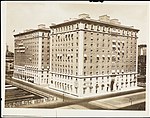Helmsley Building

The Helmsley Building is a 35-story building at 230 Park Avenue between East 45th and 46th streets in Midtown Manhattan, just north of Grand Central Terminal in New York City. It was built in 1929 as the New York Central Building and was designed by Warren & Wetmore in the Beaux-Arts style. It was the tallest structure in the "Terminal City" complex around Grand Central prior to the completion of what is now the MetLife Building. The Helmsley Building carries vehicular traffic through its base: traffic exits and enters the Park Avenue Viaduct through two portals passing under the building. The lobby of the building is between the vehicular portals. Flanking the viaduct's ramps are passageways connecting 45th and 46th streets, with entrances to Grand Central Terminal. Before the construction of Grand Central Terminal, the area to the north of the predecessor Grand Central Depot was occupied by an open-air rail yard; the tracks and depot were operated by the New York Central Railroad. After the terminal was completed in 1913, the tracks were buried under a series of buildings that were constructed over the tracks as part of the Terminal City development. The New York Central Building was erected for the railroad between 1927 and 1929 as the last major structure to be built within Terminal City. It was renamed the New York General Building in 1958 and the Helmsley Building in 1978, though ownership was changed several times afterward. The building's facade and lobby became New York City designated landmarks in 1987.
Excerpt from the Wikipedia article Helmsley Building (License: CC BY-SA 3.0, Authors, Images).Helmsley Building
East Helmsley Walk, New York Manhattan
Geographical coordinates (GPS) Address Nearby Places Show on map
Geographical coordinates (GPS)
| Latitude | Longitude |
|---|---|
| N 40.754444444444 ° | E -73.975833333333 ° |
Address
Grand Central Terminal
East Helmsley Walk
10169 New York, Manhattan
New York, United States
Open on Google Maps









